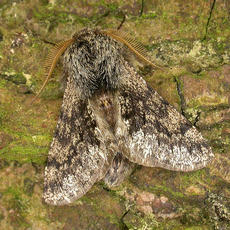Small Brindled Beauty - Apocheima hispidaria
Wingspan 28 to 35 mm. The males of this species are quite variable, with some individuals having a darker central band, others more uniformly coloured. The females are wingless and generally brownish in colour.
In the males, the small size and yellow antennae help to distinguish it from the more common Pale Brindled Beauty.
Well wooded areas especially those containing the foodplants.
An early spring species, the adults are out in February and March, when the males come to light, and the females may be found on the trunks of trees.
The main foodplant is Oak occasionally other trees such as Hazel and Elm.
Reasonably common in southern England and Wales, it can be found locally as far north as Yorkshire. In a recent survey to determine the status of all macro moths in Britain this species was classified as local.
It appears to be uncommon in Leicestershire and Rutland, where there are few records. L&R Moth Group status = D (rare or rarely recorded).
Leicestershire & Rutland Map
Enter a town or village to see local records
MAP KEY:
Yellow squares = NBN records (all known data)
Coloured circles = NatureSpot records: 2025+ | 2020-2024 | pre-2020
UK Map
Species profile
- Common names
- Small Brindled Beauty
- Species group:
- Moths
- Kingdom:
- Animalia
- Order:
- Lepidoptera
- Family:
- Geometridae
- Records on NatureSpot:
- 3
- First record:
- 28/02/2009 (Skevington, Mark)
- Last record:
- 13/03/2021 (Leonard, Pete)
Total records by month
% of records within its species group
10km squares with records
The latest images and records displayed below include those awaiting verification checks so we cannot guarantee that every identification is correct. Once accepted, the record displays a green tick.
In the Latest Records section, click on the header to sort A-Z, and again to sort Z-A. Use the header boxes to filter the list.


